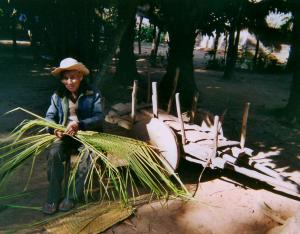Documentation of Reyesano

Landing page image for the collection “Documentation of Reyesano”. Click on image to access collection.
| Language | Reyesano |
| Depositor | Antoine Guillaume |
| Affiliation | Centre National de la Recherche Scientifique & University Lyon 2 |
| Location | Bolivia |
| Collection ID | 0009 |
| Grant ID | IPF0007 |
| Funding Body | ELDP |
| Collection Status | Collection online |
| Landing Page Handle | http://hdl.handle.net/2196/be5dc4c9-99ad-4aca-89eb-036f0f9dad8a |
Summary of the collection
English: Audio and video recordings with transcriptions and photos of speakers of Reyesano, a highly endangered language spoken in Reyes, Bolivia, resulting from fieldwork conducted between April 2003 and October 2005.
Español: Este depósito consiste en grabaciones de audio y video con transcripciones y fotos de hablantes de Reyesano, un idioma en mucho peligro de extinción que se habla en Reyes, Bolivia, que resultan de trabajo de campo realizado entre abril 2003 y octubre 2005.
Group represented
The Reyesano community (also called Maropa) are an ethnic group of about 4000 people. Most Reyesano people live in and around the two villages of Reyes (hence the name ‘Reyesano’) and Santa Rosa in the Ballivián province (Beni department) in the Amazonian plains of Bolivia, south of the Takana territory, close to the eastern foothills of the Andes.
Reyesano are not officially represented by any local organisation. However, the new Bolivian Constitution of 1992 recognizes the rights of indigenous people to their culture and language; and the national organization Central Indígena del Oriente Boliviano, together with the Ministry of Education, the Sub-Ministry of Ethnic Affairs, broadly represents their interests.
Language information
Reyesano is one of the most endangered and least known languages of the Takana family from the Amazonian rainforests of northern Bolivia and eastern Peru.
Very little is known about the five remaining Takana languages (Araona, Cavineña, Ese Ejja, Takana and Reyesano), but like other Amazonian languages they are of interest to linguists for their typologically unusual features and what they can show about the history of South American languages and populations – for example, about their relationship with the Pano language family of northern Bolivia, Peru and Brazil.
Features of typological interest include the cross-referencing system (unusually realised as second position clitics and with a split-ergative pattern depending of factors that are extremely complex to determine), the verb morphological structure (highly polysynthetic), and the auxiliaries/copula construction (with an unusually high functional load).
The Reyesano language is almost extinct and has not previously been documented, apart from an unpublished word list. Most Reyesano are monolingual in Spanish, but there are still some elders who speak the language.
Collection contents
English: The collection comprises over 230 audio and video recordings, transcriptions and Spanish and English translations of some of the recordings, photos, dictionaries and grammars.
The recordings include descriptions of life, the natural world and traditional activities, stories, and elicitation of vocabulary.
Español: El depósito consta de más de 230 grabaciones de audio y video, transcripciones y traducciones en castellano e inglés de algunas grabaciones, fotos, diccionarios y gramáticas.
Collection history
This project follows the researcher’s previous fieldwork on the Cavineña language, another member of the Takana family.
These recordings are also stored in the library of the Bolivian national indigenous organization Central Indígena del Oriente Bolivino (CIDOB) at Santa Cruz de La Sierra, and the laboratory of Dynamique du Langage at Lyon.
Other information
- This is a progressive collection – further metadata and navigation will be progressively added
- Most resource bundles in this collection consist of the following file types:
-
- *.wav – an audio file
- *.mov – a video file
- *_meta.rtf – a metadata file – information about the content
- *.txt – a transcription, in Toolbox software format (viewable in any text editor)
- *.eaf – a transcription, in ELAN software format (viewable in any text or XML viewer, e.g. a browser)
Acknowledgement and citation
Users of any part of the collection should acknowledge Antoine Guillaume as the principal investigator, the data collector and the researcher. Users should also acknowledge the Endangered Languages Documentation Programme (ELDP) as the funder of the project. Individual speakers whose words and/or images are used should be acknowledged by respective name(s). Any other contributor who has collected, transcribed or translated the data or was involved in any other way should be acknowledged by name. All information on contributors is available in the metadata.
To refer to any data from the collection, please cite as follows:
Guillaume, Antoine. 2005. Documentation of Reyesano. Endangered Languages Archive. Handle: http://hdl.handle.net/2196/00-0000-0000-0000-F53B-C. Accessed on [insert date here].
-


